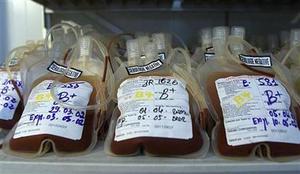
|
| ©REUTERS/Chor Sokunthea |
| Bags of donated blood in cold storage at the National Blood Transfusion Center in the Cambodian capital Phnom Penh on April 27, 2002 |
Researchers at Duke University Medical Center in Durham, North Carolina, have found that nitric oxide in red blood cells is the key to transferring oxygen in the blood to tissues.
This gas appears to break down almost immediately after red blood cells leave the body, rendering much of the blood stored in blood banks impaired, said Dr. Jonathan Stamler, a Duke researcher whose work appears in the Proceedings of the National Academy of Sciences.
"If you don't have nitric oxide in there, you can't get oxygen into the tissues," he said in a telephone interview.
But if you restore this gas, banked blood appears to regain this ability, Stamler said.
"The medical community for the past five to eight years has really been struggling with this issue of blood not being quite as good as we'd hoped," Stamler said.
He noted that study after study has shown patients who receive blood transfusions have higher incidents of heart attacks, heart failure, stroke and even death.
"This is not a new issue. It has been a long struggle," he said.
While researchers have understood that banked blood is not the same as the blood in the body, the exact difference was not well understood.
"I think we have a good explanation and I think we have a solution," Stamler said.
He and colleagues at Duke measured levels of nitric oxide in stored human blood obtained from a commercial supplier and found that nitric oxide levels started dropping quickly.
They also tested the theory on dogs. When given stored blood, the flow of oxygen-rich blood was impaired. But when they added nitric oxide back to stored blood, blood flow was restored.
A second team at Duke led by Dr. Timothy McMahon documented the depletion of nitric oxide in banked blood.
"We were surprised at how quickly the blood changes; we saw clear indications of nitric oxide depletion within he first three hours," he said in a statement.
His study appears in the same journal.
Both researchers called for clinical trials to study exactly who might benefit from banked blood.
And they said researchers should begin studying ways to safely add nitric oxide back into banked blood to see how this might improve its effectiveness.
Currently, about 5 million Americans receive blood transfusions each year, according to the National Institutes of Health.



Reader Comments
to our Newsletter